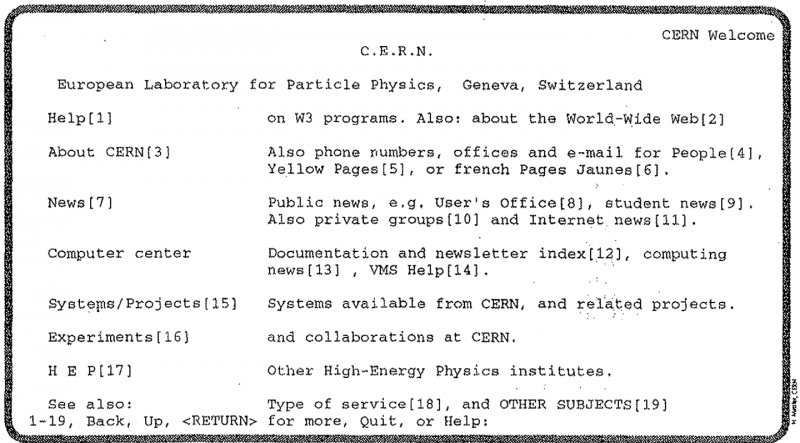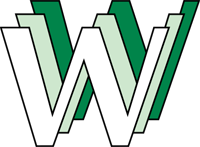CERN wants to bring the line-mode browser experience back to life so that people can step back in time and relive what it was like to browse the web in the very early days. No images, no colours, no clicking – just content. An unimpressive medium to a modern audience, the line-mode browser is nevertheless one of the key cultural assets associated with the story of how the web began.
What is the line-mode browser?
The first browser, built by Tim Berners-Lee on a NeXT computer, was really quite sophisticated; it was also beyond the capabilities of most of the computers in use at the time.
The first browser needed to impress: it had get people to champion the WWW project, it had to hint at how powerful and useful the web could become. It had graphical capabilities, users would follow links by pointing to them with a mouse - then still a relatively new input device - and it even had a contributor mode where users could create and link content together right from the browser.
The NeXT computer and its advanced graphical interface was the perfect machine on which to build the prototype browser that would impress an audience new to the web. But it was also very different from the computers that most people used at the time. In order to get WWW to be widely adopted, the team at CERN needed to develop a much simpler browser that could work with a wide variety of computers and terminals, some of them rather basic.
They hired a young student called Nicola Pellow to write such a browser. It was so simple that a terminal with a screen only capable of showing 24 rows of 80 characters, and with no mouse, could run it. It was called the line-mode browser.

A screenshot of the line-mode browser interface showing the CERN website from around 1993. This image appeared in an article written by Tim Berners-Lee and Robert Cailliau that appeared in the journal Tagung Deutsches ForschungsNetz encouraging academics and researchers to try a new technology that they called 'World Wide Web'. The line-mode browser was designed to be used by very simple computers that might not have graphical capabilities or newfangled input devices like a mouse. Numbers in square brackets appear next to hyperlinks that can be followed by typing the number and hitting the Enter key.
Developers: apply to take part
The team behind the CERN project to restore the first website is inviting a small number of developers to come to CERN to take part in a two-day coding event on 19 and 20 September 2013 to create a line-mode browser that runs right from a modern browser. By the end of this event we hope to have a working emulator that would allow visitors to the first website to experience it via a line-mode browser interface.
Are you a leading front-end web developer? Can you hand-roll beautiful CSS in your sleep? Do you eat javascript for breakfast? Are you passionate about the web and its history? If so, we'd love for you to apply to come along and help. Here's what it would involve:
- Come to CERN in Geneva, Switzerland, for two days (19-20 September 2013) and work in a small team to produce a line-mode browser emulator
- Visit some experiments and other cool stuff
- CERN is working to find sponsors to offer flat bursaries towards participants' travel and accommodation expenses
Some important notes before you apply:
- A group rate for nearby accommodation will be offered but it will be up to you, should you be successful in your application, to arrange and pay for both your travel and accommodation
- Bursaries will be offered at a flat rate. If you incur additional travel and accommodation expenses these will be up to you to cover
- Do not arrange travel or accommodation unless you have had written confirmation from CERN that your application has been accepted
- Places are extremely limited. Please do not be disappointed if you are not selected. In many, many cases not being accepted is not a reflection of your suitability but simply the fact that we have so few places available.
Still keen to apply? Go for it!
Note: do not express an interest in taking part by using the comment form on this page - use the application form
Dan Noyes on

Comments
Submitted by Emma Garland (not verified) on 19 Jun 2013 Permalink
I remember the excitement as
I remember the excitement as a child when my dad got us connected to the Internet. Sharing poems, reading up about pets and computer game cheats. Now I'm a web developer by day (and night), and I love everything about it.
I was recently lucky enough to visit CERN for a free tour and I was blown away, staring through the control room at the developers working on the AMC. I wanted to be there, wanted to see the apps they were working on, and get involved hands-on. I'd love to give something back, CERN has already offered us so much.
This would be an awesome opportunity, and as a female in tech, I'd love to get the chance to show that female developers can be coding heroes too.
Submitted by Joe Clark (not verified) on 21 Jun 2013 Permalink
Fundamentally, how is this
Fundamentally, how is this project different from rewriting Lynx from scratch? Lynx already exists.
Submitted by Stephen (not verified) on 27 Jun 2013 Permalink
Uhm... wouldn't this be just
Uhm... wouldn't this be just a few lines of a CSS file?
/*CSS*/
* {
background-color:#fff;
border:0;
color:#000;
font-family:"Courier New", Courier, fixed-width;
font-size:10pt;
text-decoration:none;
outline:0;
padding:0;
margin:0;
}
img{
display:none;
}
etc.